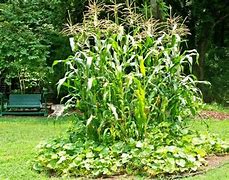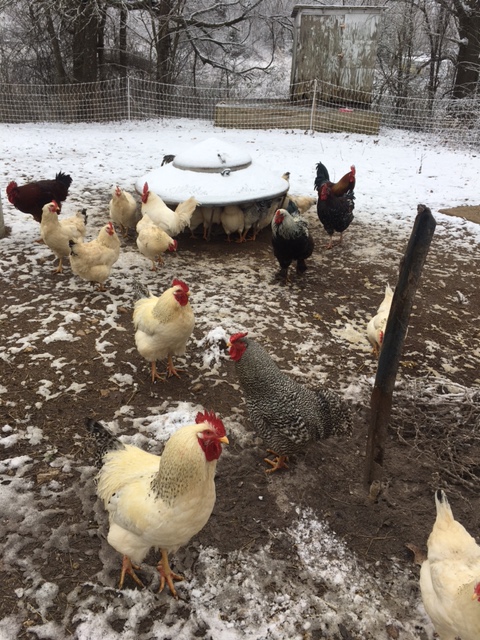
In my last post, I suggested the first two things that you can do to begin preparing a survival garden.
The first one is to purchase my book, The Survival Garden. Here’s the Amazon Link to the eBook. Here’s the link to a paperback copy.
The second is to purchase a supply of the vegetables suggested for your winter nutrition from your local market so that you can have them throughout the winter to begin your own survival vegetable experience.
In this post, I will show you eight other ways that you can begin your survival garden this fall.
Allow Livestock to Help Clear and Fertilize the Garden

The first one is to allow livestock to help clear and fertilize the garden.
Most of the time we try to keep the animals OUT of the garden, but this time of year, having animals in the garden is helpful.
The idea is that once your crop is harvested from the land, you can send your animals in to clean things up a bit before winter. You can even send in more than one animal type to do even more of your garden work.
Send in cows to clean out what they want, send in sheep to eat what they want, then send in pigs to eat what they want and finally send in chickens to pick out what’s left and to get rid of any bugs that are thinking about over wintering in your garden.
If all you have is chickens, it’s okay. Just run them through your garden and see how much “damage” a few birds can do!
Preparing the Soil

Don’t wait until spring to prepare your garden beds for planting. If you have the time before winter sets in, prepare your beds now. Once you have allowed animals to benefit from your garden wastes, it’s a good time to prepare the soil. This way you can tailor each bed to the needs of the plants that you’ll plant in that area in the spring.
Only dig up the areas that you are going to actually be planting in the fall. Any areas that the animals dug up that is on a slight slope, rake evenly and sprinkle cover crop seed in that location to prevent erosion.
Cover the Soil
Once your ground is exposed, it is a good idea to cover it to prevent erosion and nutrient depletion. There are two fantastic ways to do this. You can either mulch the area or use a cover crop. Both are good choices. Mulches and cover crops are both composed of biological mass, either once-living or still-living, used to optimize soil conditions.
Mulches consist of dead plant material like compost, leaves, spoiled hay, grass clippings and pine needles. During the summer they keep the soil moist and control weeds that could rob water from the crop. During the winter months, it helps protect the soil from harsh weather fluctuations and keep water from running off. Mulches are best used on level beds or terraces. One of the best mulches and most readily available mulches in the fall is autumn leaves.
Plant cover crops in areas of the garden that are on sloped areas and are also a good choice for pathways during the winter months. Cover crops help prevent soil erosion because the roots hold onto the soil to prevent erosion. In addition, the foliage above ground, even when not growing, protects the soil from extremes in weather and breaks up rain droplets before hitting the ground. The roots absorb the rain and hold it in place so it can be used by garden plants later.
Make Compost
Compost can be made in many different ways. A cold compost consists of layering compostable materials as they come and allowing nature to take its course.
A hot compost is a science experiment that can offer high quality nutrition for garden plants and is produced from yard and house wastes that would otherwise end up in a landfill. You can create hot compost quickly, so you really want to wait until early spring to actually start creating hot compost. However, now is a good time to start piling your brown composting materials in preparation for combining with the green materials in the spring.
Fall can be a fantastic time to start cold composting, however. Starting compost can be as easy as burying a pile of shredded brown and green yard and kitchen wastes in a garden bed and covering it with mulch. By spring, the wastes will be black gold compost that you can use immediately.
Save Garden Seed
If you have garden plants that are going to seed, now is the time to collect it, air dry it and get it ready for next season.
Plant Biennials to Save for Seed
In addition to seed saving, if you’re in an area where this is possible, consider planting biennials that you might be able to get seed from next summer. Begin planning in the early in the fall months and allow them to grow until well after the first frost. Later, you’ll be deeply mulching or digging up these vegetables for the winter. If you dig them up, you’ll be re-planting these same plants in the spring. If you leave them in the ground, you may instead wish to use these vegetables in the early spring before your garden begins producing in the new season. Use them before they begin growing again in the spring.
Plant Garlic

Once you have some ground prepared for your spring garden, take some of that to plant garlic. Garlic produces better, more reliable bulbs if planted in the autumn months rather than in the spring. Plant garlic when you plant daffodil and other early spring bulbs.
Plant Sweet Potatoes Indoors

Rather than waiting until spring to create slips from sweet potatoes from a sweet potato root, I started collecting sweet potato roots with the stems and leaves attached in the fall and planting them in containers in the house to last all winter.
Sweet potatoes are perennials so, the roots have the same genetics as the sweet potato. This enables me to eat the big sweet potatoes rather than keeping some back for producing slips.
Because I am growing the roots all winter, the plants produce more slips in the spring and uses parts of the sweet potato plant that I don’t usually use. I also get the added benefit of access to the sweet potato leaves that I can use during the winter months. These leaves are delicious and can be eaten raw or steamed and provide even more nutritional value than the sweet potato tubers.
With the days shortening and the nights lengthening, you often don’t have enough time in the day to get everything done, but if you’re able to do these ten things this fall, you’ll have a head start toward producing your own survival garden.